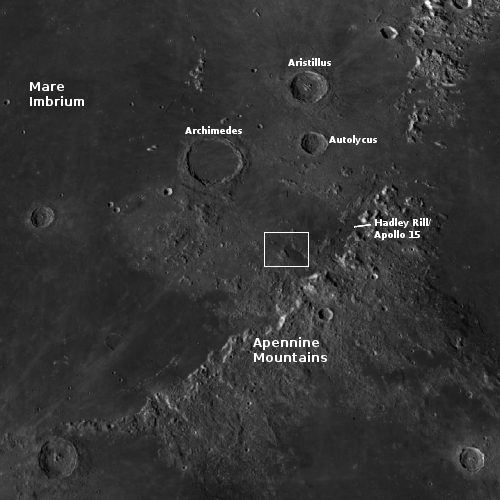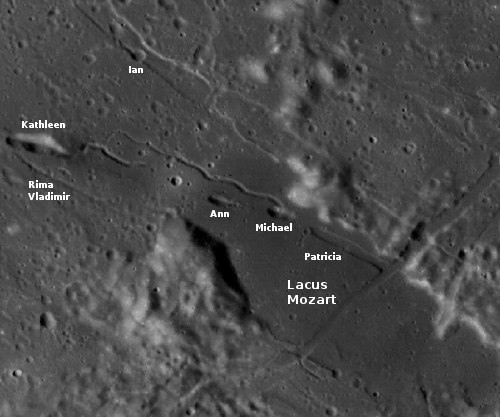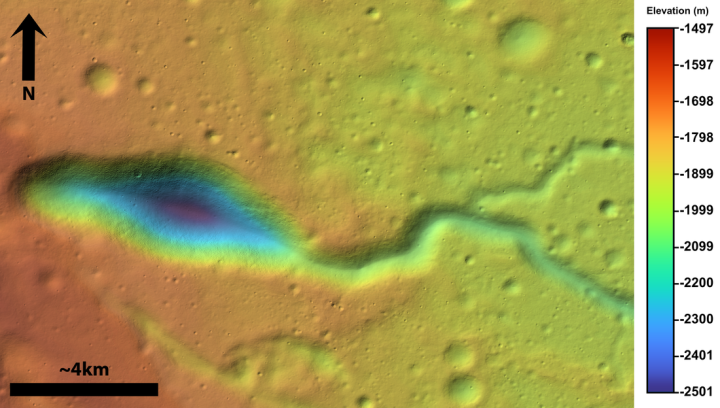A minor rill on the Moon
Cool image time! The image above, reduced to post here, is a colorized digital terrain model produced from Lunar Reconnaissance Orbiter (LRO) data. On top of the original mosaic of photos the LRO science team has overlaid the elevation data obtained by LRO’s laser altimeter. It shows a tadpole shaped pit dubbed Kathleen, with its tail trailing off to the southeast. As they note:
Kathleen is a pyroclastic vent with a sinuous rille (colloquially known as Rima Mozart [Not IAU confirmed]) that extends from the southeast end of the vent. Rilles are large channels formed by sustained channelized lava flows. This vent is a great location to investigate ancient volcanism on the Moon.
The elevation data reveals one interesting feature: The lowest part of the vent pit is not at its western end, where one would think at first glance, based on the general dip that produced the rill flowing to the east. That the lowest point is at the widest section of the pit instead suggests that this pit no longer looks as it did when it was venting. In the almost four billion years since it is thought all volcanic activity here ceased, there has been plenty of time for the slow erosion processes on the Moon, caused by radiation, micrometeorites, and the solar wind, to partly fill this pit and round out its cliff walls.
The two overview maps below provide some context.


This volcanic vent sits inside the large mare basin dubbed Mare Imbrium, or in English the Sea of Showers. The Apennine Mountains form the mare’s southeast margin, with Hadley Rille, the landing site of Apollo 15 tucked just inside the mare. The white box is the area shown in the closer overview below that focuses on the entire rill and nearby similar vents.
According to this paper, the origin of Kathleen and the surrounding vents is explained as follows:
Construction of Rima Mozart began with an explosive eruption at Kathleen Crater. A limited amount of pyroclastic debris was emplaced around this source vent. Lava erupted at Kathleen, carved a channel to the southeast, and spread out in the low-lying region now occupied by Lacus Mozart … Lava from this first eruption may have formed a tube along the channel. If so, almost all of this tube is now collapsed.
…Kathleen erupted at least one more time to form the second channel. … This eruption may have also had an explosive phase which contributed to the blanket of pyroclastic material surrounding the crater.
All of this occurred a long time ago. Since then nothing much has really happened except for those slow erosion processes, interrupted violently and abruptly by the impact of a larger asteroid at random times.
On Christmas Eve 1968 three Americans became the first humans to visit another world. What they did to celebrate was unexpected and profound, and will be remembered throughout all human history. Genesis: the Story of Apollo 8, Robert Zimmerman's classic history of humanity's first journey to another world, tells that story, and it is now available as both an ebook and an audiobook, both with a foreword by Valerie Anders and a new introduction by Robert Zimmerman.
The print edition can be purchased at Amazon or from any other book seller. If you want an autographed copy the price is $60 for the hardback and $45 for the paperback, plus $8 shipping for each. Go here for purchasing details. The ebook is available everywhere for $5.99 (before discount) at amazon, or direct from my ebook publisher, ebookit. If you buy it from ebookit you don't support the big tech companies and the author gets a bigger cut much sooner.
The audiobook is also available at all these vendors, and is also free with a 30-day trial membership to Audible.
"Not simply about one mission, [Genesis] is also the history of America's quest for the moon... Zimmerman has done a masterful job of tying disparate events together into a solid account of one of America's greatest human triumphs."--San Antonio Express-News
Cool image time! The image above, reduced to post here, is a colorized digital terrain model produced from Lunar Reconnaissance Orbiter (LRO) data. On top of the original mosaic of photos the LRO science team has overlaid the elevation data obtained by LRO’s laser altimeter. It shows a tadpole shaped pit dubbed Kathleen, with its tail trailing off to the southeast. As they note:
Kathleen is a pyroclastic vent with a sinuous rille (colloquially known as Rima Mozart [Not IAU confirmed]) that extends from the southeast end of the vent. Rilles are large channels formed by sustained channelized lava flows. This vent is a great location to investigate ancient volcanism on the Moon.
The elevation data reveals one interesting feature: The lowest part of the vent pit is not at its western end, where one would think at first glance, based on the general dip that produced the rill flowing to the east. That the lowest point is at the widest section of the pit instead suggests that this pit no longer looks as it did when it was venting. In the almost four billion years since it is thought all volcanic activity here ceased, there has been plenty of time for the slow erosion processes on the Moon, caused by radiation, micrometeorites, and the solar wind, to partly fill this pit and round out its cliff walls.
The two overview maps below provide some context.


This volcanic vent sits inside the large mare basin dubbed Mare Imbrium, or in English the Sea of Showers. The Apennine Mountains form the mare’s southeast margin, with Hadley Rille, the landing site of Apollo 15 tucked just inside the mare. The white box is the area shown in the closer overview below that focuses on the entire rill and nearby similar vents.
According to this paper, the origin of Kathleen and the surrounding vents is explained as follows:
Construction of Rima Mozart began with an explosive eruption at Kathleen Crater. A limited amount of pyroclastic debris was emplaced around this source vent. Lava erupted at Kathleen, carved a channel to the southeast, and spread out in the low-lying region now occupied by Lacus Mozart … Lava from this first eruption may have formed a tube along the channel. If so, almost all of this tube is now collapsed.
…Kathleen erupted at least one more time to form the second channel. … This eruption may have also had an explosive phase which contributed to the blanket of pyroclastic material surrounding the crater.
All of this occurred a long time ago. Since then nothing much has really happened except for those slow erosion processes, interrupted violently and abruptly by the impact of a larger asteroid at random times.
On Christmas Eve 1968 three Americans became the first humans to visit another world. What they did to celebrate was unexpected and profound, and will be remembered throughout all human history. Genesis: the Story of Apollo 8, Robert Zimmerman's classic history of humanity's first journey to another world, tells that story, and it is now available as both an ebook and an audiobook, both with a foreword by Valerie Anders and a new introduction by Robert Zimmerman.
The print edition can be purchased at Amazon or from any other book seller. If you want an autographed copy the price is $60 for the hardback and $45 for the paperback, plus $8 shipping for each. Go here for purchasing details. The ebook is available everywhere for $5.99 (before discount) at amazon, or direct from my ebook publisher, ebookit. If you buy it from ebookit you don't support the big tech companies and the author gets a bigger cut much sooner.
The audiobook is also available at all these vendors, and is also free with a 30-day trial membership to Audible.
"Not simply about one mission, [Genesis] is also the history of America's quest for the moon... Zimmerman has done a masterful job of tying disparate events together into a solid account of one of America's greatest human triumphs."--San Antonio Express-News



Somewhere I’ve missed something in all my reading. I didn’t think the moon had a molten core? How do these form if so? I thought, supposedly, it’s just a dead rock. Although the “ringing” sound the astronauts mentioned is a little mystifying.
Ruth: The Moon’s core is today believed to be solid. At one time however (4 billion years ago) the surface was being heavily reshaped by volcanic activity, linked to internal matters as well as the heavy bombardment from objects within the solar system. Mare Imbrium is believed to have been caused by a big impact, and was then flooded with impact melt.
What is the temperature at the center of the moon at present thought to be?